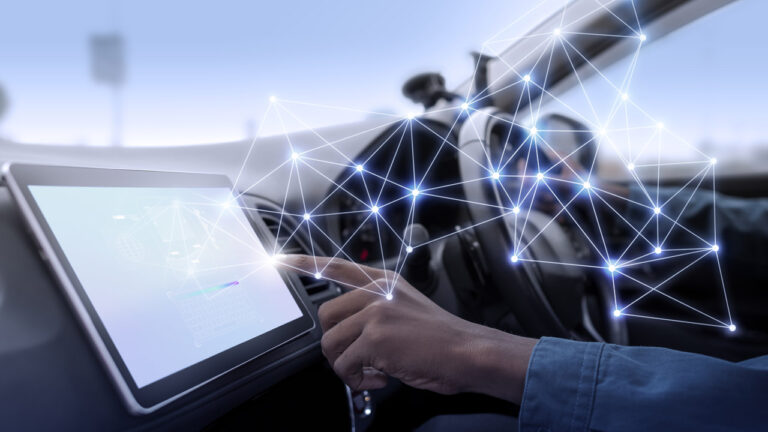
Software-defined vehicles (SDVs) represent the cutting edge of automotive technology, where the majority of vehicle functions and features are controlled and updated through software. This paradigm shift enables greater flexibility, improved functionality, and continuous improvement of vehicle performance and user experience. Software-defined vehicle architecture forms the backbone of this innovative approach, integrating various electronic systems into a cohesive, updatable platform. SDV software defined vehicle solutions are transforming the automotive landscape, paving the way for smarter, more connected vehicles.
Table of Contents
Software-defined vehicle architecture is the framework that allows for the integration and control of a vehicle’s systems via software. This architecture decouples hardware from software, enabling more frequent updates and enhancements without the need for physical changes to the vehicle. By centralizing control into a few powerful computing units, SDV architecture simplifies the vehicle’s electronic systems, making it easier to manage and improve over time. This approach supports a wide range of functionalities, from infotainment and navigation to advanced driver-assistance systems (ADAS) and autonomous driving capabilities.
Key Benefits of Software-Defined Vehicle Solutions
- Enhanced Flexibility: Software updates can be deployed over-the-air (OTA), allowing manufacturers to add new features and fix issues without requiring a visit to the dealership.
- Improved Safety: Continuous software improvements ensure that safety features are always up-to-date, providing the best possible protection for drivers and passengers.
- Cost Efficiency: Reducing the reliance on hardware upgrades minimizes costs associated with vehicle recalls and physical part replacements.
- Customization and Personalization: SDV solutions allow users to customize their driving experience, from adjusting performance settings to personalizing in-car entertainment.
- Extended Vehicle Lifespan: Regular software updates keep vehicles current with the latest technology and performance enhancements, extending their usable life.
Practical Applications of Software-Defined Vehicle Solutions
In the realm of infotainment, software-defined vehicles offer a seamless and personalized user experience, with real-time updates to maps, media, and connectivity features. ADAS capabilities are significantly enhanced through SDV software-defined vehicle solutions, enabling features such as lane-keeping assist, adaptive cruise control, and automated parking. Additionally, electric vehicles (EVs) benefit from software-defined architectures by optimizing battery management and energy efficiency, ensuring that the vehicle performs optimally under various conditions. This versatility demonstrates the comprehensive impact of SDVs on modern vehicle functionality and user experience.
Future Trends and Opportunities in Software-Defined Vehicles
The future of software-defined vehicles is bright, with numerous trends and opportunities on the horizon. One significant trend is the increasing integration of artificial intelligence (AI) and machine learning, which will enhance the decision-making capabilities of autonomous vehicles. The rise of connected car ecosystems will also play a crucial role, as SDVs can communicate with other vehicles and infrastructure to improve traffic flow and safety. Moreover, the shift towards electric and autonomous vehicles will drive further innovation in software-defined vehicle architecture, enabling more advanced and efficient systems. These trends highlight the growing importance and potential of SDVs in shaping the future of mobility.
Industries Benefiting from Software-Defined Vehicle Solutions
- Automotive: Central to the development of advanced, autonomous, and connected vehicles.
- Telecommunications: Provides the infrastructure necessary for vehicle connectivity and real-time data exchange.
- Smart Cities: Integrates with urban infrastructure to enhance traffic management and reduce congestion.
- Energy Sector: Supports the management of electric vehicle charging and energy distribution.
- Consumer Electronics: Extends to in-car entertainment and connectivity solutions, enhancing the user experience.
Challenges and Solutions in Software-Defined Vehicle Implementation
Implementing software-defined vehicle solutions presents several challenges. One primary challenge is ensuring cybersecurity, as increased connectivity makes vehicles more vulnerable to hacking. Another challenge is the complexity of integrating multiple software systems and ensuring they work seamlessly together. Additionally, there can be resistance from traditional automotive stakeholders who are accustomed to hardware-centric development processes.
Solutions to these challenges include investing in robust cybersecurity measures to protect vehicle systems from cyber threats. Developing standardized interfaces and protocols can simplify the integration of various software systems. Comprehensive training programs for engineers and developers can also help ease the transition from hardware-focused to software-focused development. By addressing these challenges, the industry can fully realize the benefits of software-defined vehicles.
The Impact and Future of Software-Defined Vehicle Solutions
Software-defined vehicle solutions are revolutionizing the automotive industry by enabling more flexible, efficient, and safe vehicles. As technology continues to advance, the importance of SDV architecture and solutions will only grow. Overcoming implementation challenges and embracing emerging trends will allow the industry to innovate continuously, leading to smarter, safer, and more connected vehicles. This transformation will not only enhance the driving experience but also contribute to the broader goals of sustainability and efficiency in transportation.
The Evolution of Vehicle Architecture
The transition to software-defined vehicles represents a significant shift in automotive design philosophy. Traditionally, vehicles were primarily hardware-centric, with each function controlled by a dedicated electronic control unit (ECU). This led to complex wiring harnesses and limited flexibility. The software-defined approach consolidates these functions into fewer, more powerful computing platforms, allowing for greater integration and adaptability.
Key changes in vehicle architecture:
- From Distributed to Centralized: Transition from numerous ECUs to consolidated computing platforms
- Reduced Complexity: Simplification of wiring harnesses and system integration
- Enhanced Flexibility: Easier implementation of new features and updates
- Improved Performance: More efficient resource allocation and system coordination
The Role of Edge Computing in SDVs
Edge computing plays a crucial role in the software-defined vehicle ecosystem. By processing data closer to its source (the vehicle), edge computing enables faster decision-making and reduces the need for constant cloud connectivity.
Key applications of edge computing in SDVs:
- Real-time sensor data processing for ADAS and autonomous driving
- Local AI inference for personalized user experiences
- Improved latency for critical safety functions
- Efficient management of vehicle-to-everything (V2X) communications
These capabilities are fundamental to realizing the full potential of software-defined vehicles, enhancing both safety and user experience.
Data Management and Analytics in Software-Defined Vehicles
The software-defined approach generates vast amounts of data, presenting both opportunities and challenges. Effective data management and analytics are crucial for realizing the full potential of SDVs. This data-driven paradigm enables a range of innovations that were previously unfeasible.
Data-driven innovations in SDVs:
- Predictive Maintenance: Analyzing vehicle data to anticipate and prevent failures
- Usage-Based Insurance: Tailoring insurance premiums based on driving behavior
- Fleet Management: Optimizing vehicle utilization and performance for commercial fleets
- Traffic Pattern Analysis: Improving urban planning and traffic management
These innovations showcase the transformative potential of software-defined vehicles beyond just transportation.
The Convergence of SDVs and Electric Vehicles
The rise of software-defined vehicles coincides with the increasing adoption of electric vehicles, creating synergies that enhance the capabilities of both technologies. This convergence is particularly evident in several areas of EV operation and management.
SDV-EV synergies:
- Advanced Battery Management: Optimizing battery life and performance through sophisticated algorithms
- Accurate Range Prediction: Providing reliable estimates based on various factors like driving conditions and habits
- Smart Charging: Implementing intelligent scheduling and routing for efficient charging
- Vehicle-to-Grid Integration: Enabling EVs to serve as mobile energy storage units
These integrations significantly enhance the efficiency, reliability, and utility of electric vehicles.
Regulatory Challenges and Standardization Efforts
As software-defined vehicles become more prevalent, regulatory bodies and industry stakeholders are working to establish standards and guidelines to ensure safety, security, and interoperability.
Key areas of regulatory focus:
- Cybersecurity Standards: Developing robust protocols to protect vehicles from cyber threats
- Software Update Regulations: Ensuring safe and secure over-the-air updates
- Data Privacy Guidelines: Protecting user data while enabling innovation
- Interoperability Standards: Facilitating communication between vehicles from different manufacturers
Addressing these regulatory challenges is crucial for the widespread adoption and success of SDVs.
The Impact on the Automotive Workforce
The shift towards software-defined vehicles is reshaping the automotive workforce, creating new roles and requiring new skillsets. This transformation is evident across various aspects of the industry.
Emerging roles in the SDV landscape:
- Software Engineers: Increased demand for automotive software developers
- Data Scientists: Growing need for professionals skilled in big data analytics
- Cybersecurity Experts: Essential for protecting connected vehicles from threats
- User Experience Designers: Crucial for creating intuitive and engaging in-vehicle interfaces
This shift in workforce needs represents both a challenge and an opportunity for the automotive industry, necessitating significant investments in training and education to prepare for the software-defined future.
Conclusion: The Road Ahead for Software-Defined Vehicles
Software-defined vehicles represent a paradigm shift in the automotive industry, offering unprecedented flexibility, functionality, and potential for innovation. As this technology continues to evolve, it will drive advancements in areas such as autonomous driving, vehicle connectivity, and sustainable mobility. The challenges ahead are significant, but so are the opportunities. By embracing the software-defined approach, the automotive industry is poised to deliver safer, smarter, and more efficient transportation solutions for the future.
